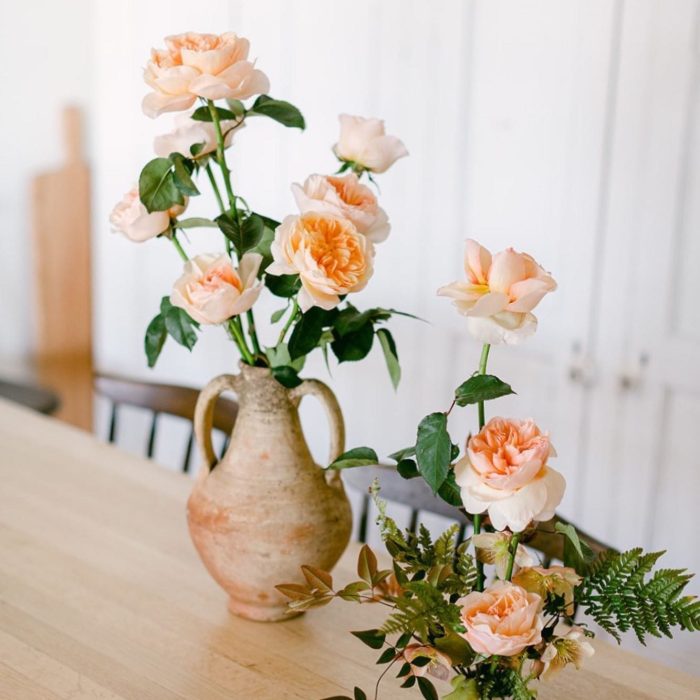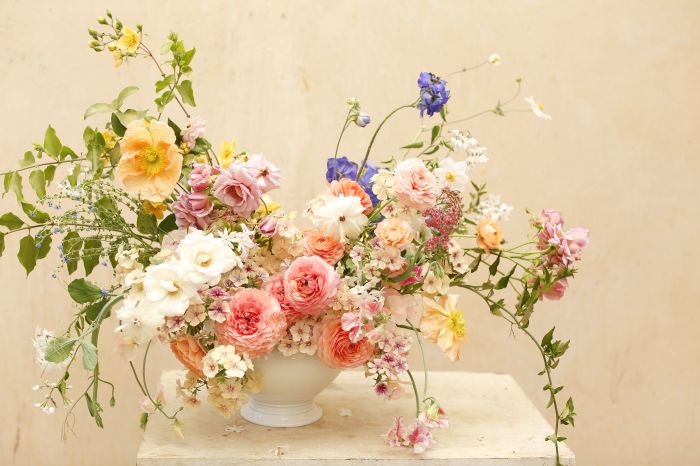Floral Decoration transforms spaces, adding beauty and emotion to any occasion. From the delicate artistry of a hand-tied bouquet to the grand spectacle of wedding centerpieces, flowers possess a unique power to enhance ambiance and express sentiment. This guide delves into the world of floral design, exploring various styles, techniques, and applications for diverse events.
We’ll journey through the history and cultural significance of floral arrangements, examining different traditions and their influence on contemporary design. We’ll also provide practical, step-by-step instructions for creating stunning arrangements, covering flower selection, preservation methods, and the use of essential tools. Finally, we’ll showcase floral decoration schemes for various events, from intimate gatherings to large-scale celebrations, offering inspiration and practical advice for achieving breathtaking results.
Types of Floral Decorations

Floral decorations encompass a vast and varied world, transforming spaces and enhancing celebrations with their beauty and symbolism. From intimate bouquets to grand installations, the artistry of floral design offers countless possibilities, shaped by occasion, style, and cultural context. This exploration delves into the diverse types of floral arrangements, their historical significance, and the creative possibilities they unlock.
Comparison of Floral Arrangement Styles
The choice of floral arrangement style significantly impacts the overall aesthetic and message conveyed. Different styles suit various occasions and personal preferences. The following table compares some popular styles:
| Style Name | Typical Flowers Used | Occasions | Design Characteristics |
|---|---|---|---|
| Bouquets | Roses, lilies, tulips, daisies – highly variable depending on style and occasion. | Weddings, birthdays, anniversaries, funerals (sympathy bouquets) | Hand-held, often tied with ribbon, diverse styles from round to cascading. |
| Centerpieces | Hydrangeas, roses, orchids, lilies, depending on table size and event formality. | Weddings, banquets, dinner parties, corporate events | Low, medium, or high arrangements; designed to enhance the dining experience; various shapes and styles. |
| Garlands | Ivy, jasmine, roses, smaller blooms suitable for stringing. | Weddings (archways, tables), festivals, celebrations, home decor | Long, flowing arrangements, often used for decoration along lines or curves. |
| Wreaths | Evergreens (pine, fir), berries, flowers (roses, poinsettias), ribbons | Christmas, holidays, memorial services, seasonal decorations | Circular arrangement, often used as a door or wall decoration. |
Cultural Significance of Floral Decorations
Floral decorations hold deep cultural significance across the globe, often carrying symbolic meaning and reflecting traditions passed down through generations.
In Japanese culture, flower arranging, known as Ikebana, is a highly refined art form with a long history. It emphasizes natural forms and asymmetry, reflecting a deep respect for nature and the transience of life. Specific flowers and their arrangement can convey different emotions and meanings, such as the cherry blossom symbolizing renewal and fleeting beauty.
Chinese floral decorations often incorporate auspicious symbols and colors, reflecting beliefs about prosperity, longevity, and good fortune. The peony, for example, represents wealth and honor, while the lotus symbolizes purity and enlightenment. Floral arrangements are frequently used in festivals and celebrations, playing a vital role in expressing cultural values.
In Victorian England, the language of flowers, or floriography, was widely practiced. Different flowers conveyed specific messages, allowing individuals to express emotions and sentiments subtly through floral gifts. A red rose, for instance, signified passionate love, while a white lily represented purity and innocence. This practice adds a layer of intricate meaning to Victorian-era floral arrangements.
Unique Floral Arrangement Designs
The following are examples of unique floral arrangement designs, showcasing the versatility and creativity of the art form:
1. Modern Minimalist Arrangement: This design features a single type of flower, such as white calla lilies, arranged sparsely in a sleek, black ceramic vase. The focus is on simplicity and elegance, creating a sophisticated and modern feel. The color palette is monochromatic, highlighting the pure white of the lilies against the dark vase.
2. Romantic Cascading Bouquet: This bouquet is characterized by a lush, overflowing cascade of roses, peonies, and hydrangeas in shades of blush pink, ivory, and soft lavender. The flowers spill gracefully from a hand-tied arrangement, creating a romantic and whimsical effect. The container could be a simple satin ribbon, allowing the flowers to be the focal point.
3. Tropical Paradise Centerpiece: This vibrant centerpiece features a mix of tropical flowers like orchids, birds of paradise, and hibiscus in bold colors such as orange, fuchsia, and bright yellow. The arrangement is lush and abundant, creating a sense of tropical warmth and energy. A large, shallow bowl or a woven basket would be a suitable container.
4. Rustic Wildflower Arrangement: This arrangement evokes a sense of natural beauty, featuring a mix of wildflowers such as daisies, sunflowers, and Queen Anne’s lace in a rustic wooden crate or a galvanized metal bucket. The color palette is a mix of warm yellows, oranges, and whites, creating a charming and relaxed atmosphere.
5. Elegant Orchid Display: This sophisticated display features a collection of various orchid varieties in shades of purple, white, and pale pink, arranged in tall, clear glass vases on a mirrored surface. The arrangement emphasizes the elegance and exotic beauty of the orchids, creating a luxurious and refined aesthetic.
Floral Decoration Techniques and Processes

Floral decoration involves a blend of artistry and technical skill. Mastering various techniques and understanding the processes involved ensures the creation of stunning and long-lasting arrangements. This section delves into the practical aspects of floral design, providing a step-by-step guide to bouquet creation, flower preservation methods, and an overview of essential tools and materials.
Creating a Classic Hand-Tied Bouquet
Constructing a hand-tied bouquet is a fundamental skill in floral design. This method allows for a natural, flowing aesthetic and offers a degree of flexibility in design. The following steps Artikel the process:
- Flower Selection: Choose a variety of flowers with contrasting textures, colors, and heights. Consider the overall shape and balance you desire. A good starting point might be 3-5 main focal flowers, several filler flowers, and some greenery for texture.
- Flower Preparation: Remove any lower leaves that would fall below the waterline in the vase. Cut the stems at a 45-degree angle to maximize water uptake. This also helps prevent the stem from sitting flat on the bottom of the vase and blocking water absorption.
- Stem Grouping: Start with your focal flowers, holding them in your dominant hand. Add filler flowers and greenery, gradually building the bouquet. Ensure that stems are held firmly and evenly spaced to create a balanced arrangement.
- Securing the Bouquet: Use floral tape to gently secure the stems together near the base. Wrap the tape around several times, ensuring that the stems are tightly bound but not crushed. This tape should ideally be flexible, strong, and waterproof.
- Final Adjustments: Rotate the bouquet, checking for balance and symmetry. Trim any uneven stems to create a clean, even base. Add any additional touches as desired.
- Wrapping (Optional): Wrap the bouquet in decorative paper or ribbon. Secure the wrapping with additional tape or twine, leaving the stems exposed at the base.
Preserving Cut Flowers, Floral Decoration
Extending the lifespan of cut flowers significantly enhances the longevity of floral arrangements. Several methods can be employed to achieve this:
- Proper Hydration: Immediately after cutting, place the flowers in a clean vase filled with fresh, cool water. Add a floral preservative solution, as directed, to inhibit bacterial growth and maintain hydration. This solution typically contains sugar and an acidifier.
- Temperature Control: Avoid placing arrangements in direct sunlight or near heat sources. These conditions can accelerate dehydration and wilting. Cooler temperatures prolong the life of flowers.
- Regular Maintenance: Change the water every day or two, and recut the stems at a 45-degree angle. Remove any wilting or decaying flowers promptly to prevent the spread of bacteria.
- Flower Food: Use commercial flower food, which provides essential nutrients and helps maintain pH levels. These foods are readily available from florists and garden centers.
Floral Design Tools and Materials
Various tools and materials facilitate the creation of professional-looking floral arrangements. The correct selection and application of these elements significantly impact the final result.
| Tool/Material | Function | Advantages | Disadvantages |
|---|---|---|---|
| Floral Foam (Oasis) | Provides a stable base for arranging flowers; holds water and nutrients. | Easy to use; allows for intricate designs; keeps flowers hydrated. | Can be messy; may not be suitable for all types of containers; can decompose over time. |
| Floral Wire | Provides support for delicate stems; allows for shaping and arranging. | Versatile; strong and durable; allows for creative designs. | Can be difficult to work with for beginners; may be visible in the final arrangement. |
| Floral Tape | Secures stems together; hides wire; provides support. | Easy to use; strong and flexible; comes in various colors. | Can be sticky; may leave residue on hands or flowers. |
| Floral Shears/Scissors | Precisely cuts stems; allows for clean cuts to maximize water uptake. | Sharp and efficient; provides clean cuts; improves flower longevity. | Requires careful handling to avoid injury; may require sharpening over time. |
Mastering the art of floral decoration is a rewarding journey, blending creativity, technical skill, and an understanding of the emotional impact of flowers. Whether you’re a seasoned florist or a passionate beginner, this comprehensive guide provides the knowledge and inspiration to create unforgettable floral arrangements for any occasion. From understanding the nuances of different flower types to mastering various arrangement techniques, the possibilities are endless.
Embrace the beauty and artistry of floral design, and let your creativity bloom!